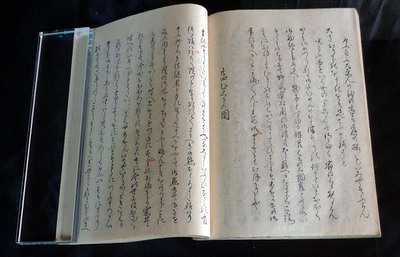Difference between revisions of "Ogimachi Machiko"
From SamuraiWiki
Jump to navigationJump to search| (2 intermediate revisions by the same user not shown) | |||
| Line 1: | Line 1: | ||
[[File:Matsukage-nikki.jpg|right|thumb|400px|A copy of ''Matsukage no nikki'' on display at the [[Toyo Bunko|Tôyô Bunko]]]] | [[File:Matsukage-nikki.jpg|right|thumb|400px|A copy of ''Matsukage no nikki'' on display at the [[Toyo Bunko|Tôyô Bunko]]]] | ||
| + | *''Born: [[1679]]?'' | ||
| + | *''Died: [[1724]]'' | ||
*''Japanese'': [[正親町]] 町子 ''(Ôgimachi Machiko)'' | *''Japanese'': [[正親町]] 町子 ''(Ôgimachi Machiko)'' | ||
Ôgimachi Machiko was the primary wife (''sokushitsu'') of [[Yanagisawa Yoshiyasu]]. She is known for her diary, ''Matsukage no nikki'', which details numerous events of that period in a writing style inspired by the ''[[Tale of Genji]]''. | Ôgimachi Machiko was the primary wife (''sokushitsu'') of [[Yanagisawa Yoshiyasu]]. She is known for her diary, ''Matsukage no nikki'', which details numerous events of that period in a writing style inspired by the ''[[Tale of Genji]]''. | ||
| + | |||
| + | She was a member of the [[Ogimachi family|Ôgimachi family]] of [[kuge|court nobles]], who traced their line to the celebrated classical scholar [[Sanjonishi Sanetaka|Sanjônishi Sanetaka]] ([[1455]]-[[1537]]).<ref>Rebeckah Clements, "Speaking in Tongues? Daimyo, Zen Monks, and Spoken Chinese in Japan, 1661–1711," ''The Journal of Asian Studies'' Vol. 76, No. 3 (August) 2017: 605.</ref> | ||
{{stub}} | {{stub}} | ||
| Line 8: | Line 12: | ||
==References== | ==References== | ||
*Gallery labels, Tôyô Bunko.[https://www.flickr.com/photos/toranosuke/35953131801/sizes/l] | *Gallery labels, Tôyô Bunko.[https://www.flickr.com/photos/toranosuke/35953131801/sizes/l] | ||
| + | <references/> | ||
[[Category:Women]] | [[Category:Women]] | ||
[[Category:Edo Period]] | [[Category:Edo Period]] | ||
| + | [[Category:Nobility]] | ||
Latest revision as of 07:45, 15 June 2020

A copy of Matsukage no nikki on display at the Tôyô Bunko
Ôgimachi Machiko was the primary wife (sokushitsu) of Yanagisawa Yoshiyasu. She is known for her diary, Matsukage no nikki, which details numerous events of that period in a writing style inspired by the Tale of Genji.
She was a member of the Ôgimachi family of court nobles, who traced their line to the celebrated classical scholar Sanjônishi Sanetaka (1455-1537).[1]
References
- Gallery labels, Tôyô Bunko.[1]
- ↑ Rebeckah Clements, "Speaking in Tongues? Daimyo, Zen Monks, and Spoken Chinese in Japan, 1661–1711," The Journal of Asian Studies Vol. 76, No. 3 (August) 2017: 605.